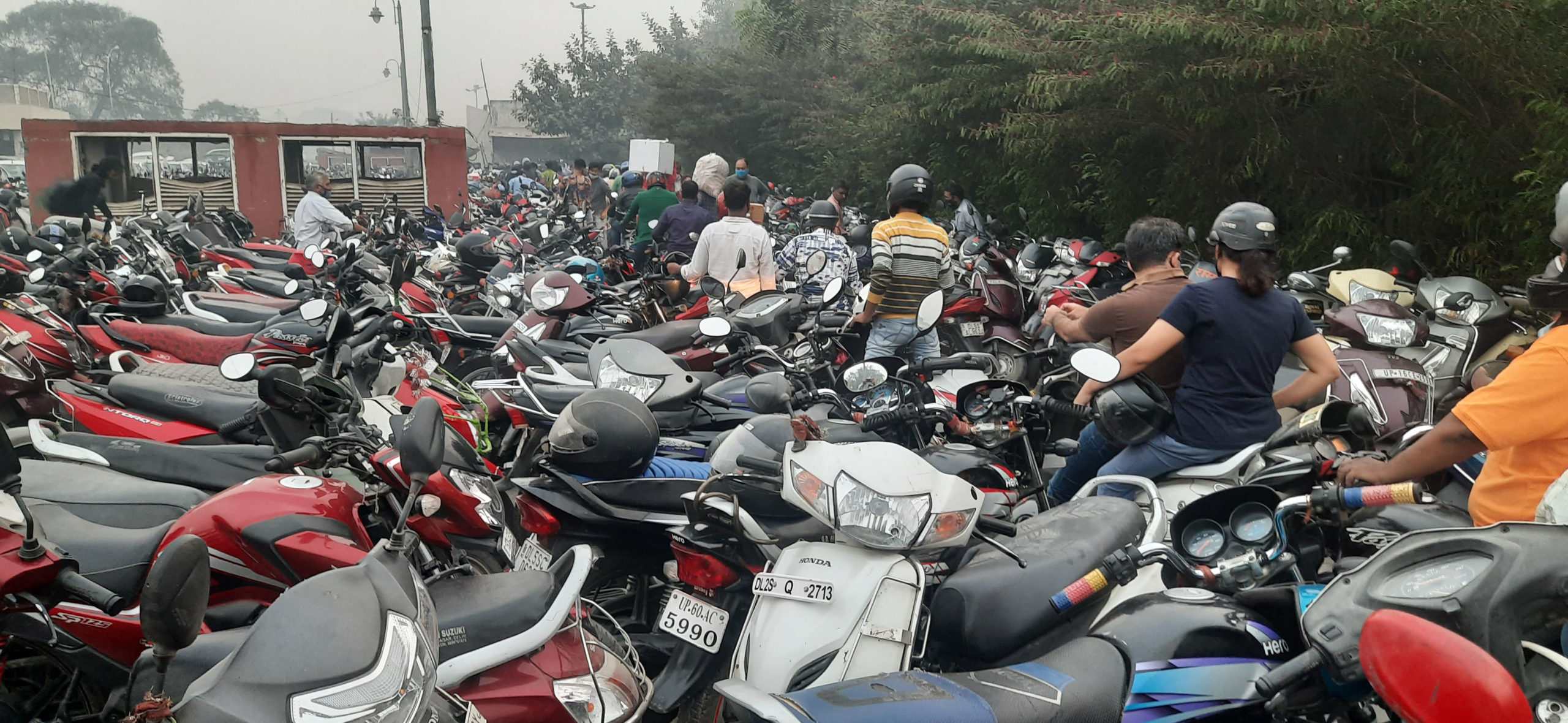
NEW DELHI, INDIA NOVEMBER 10: A view of bicycle rush at Subhash Madain MCD parking, on November 10, 2020 in New Delhi, India. (Photo by Sonu Mehta/Hindustan Times via Getty Images)
It’s 4 o’clock in the evening, when three traffic police personnel were towing four bikes on a police truck. These vehicles were parked near Malai Mandir, of Vasant Vihar region, a ‘no parking’ zone. Ajay, whose Pulsar bike was towed by police, came here to buy alcohol for his house party.
When he came back at the spot he didn’t find it, and immediately asked a nearest shopper the whereabouts of his bike, who informed him that his bike was taken by traffic police. “I didn’t know this was a ‘no parking’ zone. I had to buy alcohol and go back home, which took me hardly 10 minutes,” said Ajay with a wry smile. The whole area had various bikes and cars parked in “no parking zones”, and it seems that people park in these areas despite knowing so.
Praveen, who has a small cigarette shop near Vasant Vihar police station says, “Everyday I see police towing bikes and cars from here. But that doesn’t change people’s attitude, they would park here but not in multi-level parking facilities available to them because that would charge them money.”
Janardhan Kumar, a caretaker of a multi-level parking facility in Vasant Kunj says, “First of all, people don’t want to pay money for parking. Second, we don’t have space, we have a facility to accommodate 200 cars, not more than that.”
Space crunch seems to be the biggest concern of some multi-parking facilities in the busy south Delhi region. But it is not the case all over Delhi, majority of multi-parking facilities are underutilised. In North Delhi, a seven storeyed parking facility in Kamla Nagar has space to accommodate over 800 slots but they still do not occupy more than 200.
A traffic police personnel deployed in the Nehru Place region said that “people are ready to pay fine, but not parking charges.” This indicates that lack of enforcement of parking rules is also one of the reasons for people’s lax attitude towards parking.
Therefore, parking in Delhi has been a big concern — cars, bikes are parked haphazardly and crimes based on traffic disputes are not uncommon. In 2019, Delhi police received over 200 calls on their helpline number related to road rage, and traffic related disputes.
In 2019, the Supreme Court called parking a “most serious problem of Delhi”. It said, “The Government of NCT (national capital territory) is directed to ensure that while granting permission to build any structures, there is proper assessment of parking needs for the next 25 years and requisite parking facilities are available.”
After that Delhi government brought Delhi Maintenance and Management of Parking Places Rules, 2019, which stipulated that there would be area specific parking plans, and more spaces for pedestrians and green mode of transport. Still, parking woes couldn’t be resolved.
This problem is more challenging in Delhi’s Lal Dora villages, where years of unplanned development has not left much land for vehicle parking. The Khirki village, Lado Sarai, Munirka, Katwaria Sarai are also the areas where narrow lanes are often packed with vehicles, which manifests how these residential areas are not good for pedestrians.
Amit Bhatt, Director of integrated transport at World Resource Institute (WRI) writes in his article for National Daily that we need a progressive parking. “Finding a slot at a particular time is an old paradigm.” A paradigm of progressive parking is required.
“Studies have shown that a typical motor vehicle moves only 5% of the time. This means that the vehicle is parked for almost 23 hours in a day thereby occupying 23 sqm of real estate at least in two locations in a city. This means that the city is happily allocating at least 46 sqm of prime real estate for parking vehicles, but finding a minimum of 50 sqm for a plot or 19 sqm for flats for the Economically Weaker Section (EWS) is always a struggle,” Bhatt writes.
Therefore, the new draft Master Plan 2041 of Delhi gave primacy to rationalising existing spaces rather than creating new ones. It also suggests variable parking rates and congestion charges.
In a meeting on July 19, PWD minister Satyendra Jain suggested construction of multi-level parking under parks in residential areas and floor area ratio (FRO) regeneration, which means optimising existing space by investing money in them.
However, it is yet to see how it changes Delhi’s parking woes, which so far a biggest concern of the capital city.
(Cover: Getty Images)
Police said despite sustained efforts, the accused remained at large and kept changing locations and…
At a debut solo exhibition in Delhi, an architect-artist explores sand, memory and movement through…
Om Taneja (81) and his wife Indira (77), a doctor, were kept under “digital arrest”…
The court observed although appellant had caused death by rash and negligent act, sending him…
AAP leaders were detained during a protest against the BJP over an alleged doctored video…
NDMC is rolling out a G20-style upgrade of roads, lighting and cleanliness to prepare Delhi…